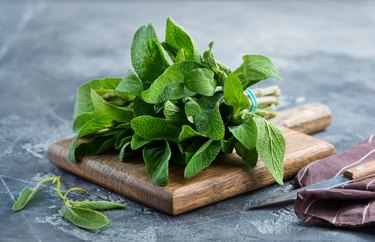
Sage leaves are commonly used in thanksgiving stuffing recipes or paired with fatty meats like lamb. You can keep fresh sage in the fridge, wrapped in a slightly damp paper towel and placed in a plastic bag, or make dried sage in your oven or using a dehydrator.
Tip
To dry sage in the oven, place the leaves in a single layer on a baking sheet lined with parchment paper. Set your oven to the lowest possible temperature and let the sage dry for an hour, rotating the tray after 30 minutes. Check every 15 minutes or so to make sure the sage is not burning in the oven. When done, the leaves will be crispy and crumble easily between your fingers.
Video of the Day
According to the National Center for Complementary and Integrative Health (NCCIH), there's not much solid research on the health benefits of fresh or dried sage leaves — so be wary when it comes to herbal supplements, Harvard Health says. But, in the kitchen, the herb adds flavor to numerous recipes and is a good staple to keep on hand.
Video of the Day
Dried Sage Benefits
The major benefit of dried sage over fresh sage is that it lasts for much longer. Once you have made your dried sage in the oven or using a dehydrator, you can store it in an airtight container kept in a cool, dry place for up to a year. If possible, try to store dried herbs away from your stove or sink, where heat and steam can affect them.
When you are making dried sage, ensure that the herb is fully dry before you remove it from the oven or dehydrator — this will prevent the herbs from becoming moldy during storage. A fully dried sage leaf will be crispy, and crumble easily between your fingers. You can store dried sage leaves whole, or grind them before storing.
Read more: What Are the Health Benefits of Sage Tea?
The National Center for Home Food Preservation says that dried herbs are actually stronger than fresh ones, so bear that in mind when substituting dried sage in any recipes. In addition, the herb is a low-calorie way to add flavor to a variety of dishes: According to the U.S. Department of Agriculture, (USDA), a teaspoon of ground, dried sage provides just over 2 calories.
You can also easily purchase sage already dried and ground, if you don't want to go through the steps of drying sage on your own. This comes with the benefit of an established expiration date, letting you know when to stop using the dried sage.
Freezing Sage
Freezing sage can also make it last for a long time. To freeze fresh sage leaves, wash them and gently pat them dry. Then pack the leaves loosely in a container like a freezer storage bag or a freezer-safe mason jar, where they can keep for up to one year.
Another option for freezing sage is to chop up fresh sage leaves and blend them with butter or olive oil. You can then pour the mixture into a small container or an ice cube tray and stash it in the freezer until you are ready to use it. Sage butter makes a wonderful addition to pasta dishes, and could also be used for sautéing vegetables or braising meats like short ribs.